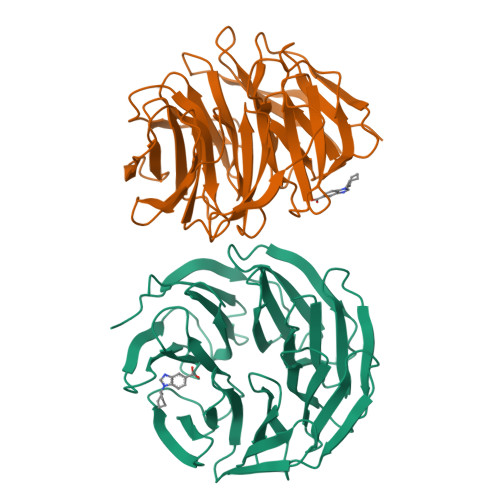Discovery of WD Repeat-Containing Protein 5 (WDR5)-MYC Inhibitors Using Fragment-Based Methods and Structure-Based Design.
Chacon Simon, S., Wang, F., Thomas, L.R., Phan, J., Zhao, B., Olejniczak, E.T., Macdonald, J.D., Shaw, J.G., Schlund, C., Payne, W., Creighton, J., Stauffer, S.R., Waterson, A.G., Tansey, W.P., Fesik, S.W.(2020) J Med Chem 63: 4315-4333
- PubMed: 32223236
- DOI: https://doi.org/10.1021/acs.jmedchem.0c00224
- Primary Citation of Related Structures:
6UHY, 6UHZ, 6UIF, 6UIK, 6UJ4, 6UJH, 6UJJ, 6UJL, 6UOZ - PubMed Abstract:
The frequent deregulation of MYC and its elevated expression via multiple mechanisms drives cells to a tumorigenic state. Indeed, MYC is overexpressed in up to ∼50% of human cancers and is considered a highly validated anticancer target. Recently, we discovered that WD repeat-containing protein 5 (WDR5) binds to MYC and is a critical cofactor required for the recruitment of MYC to its target genes and reported the first small molecule inhibitors of the WDR5-MYC interaction using structure-based design. These compounds display high binding affinity, but have poor physicochemical properties and are hence not suitable for in vivo studies. Herein, we conducted an NMR-based fragment screening to identify additional chemical matter and, using a structure-based approach, we merged a fragment hit with the previously reported sulfonamide series. Compounds in this series can disrupt the WDR5-MYC interaction in cells, and as a consequence, we observed a reduction of MYC localization to chromatin.
Organizational Affiliation:
Department of Chemistry, Vanderbilt University, Nashville, Tennessee 37232, United States.




















